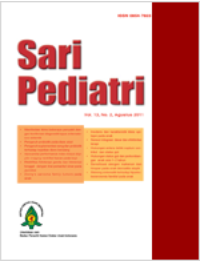Diare Rotavirus pada Anak Usia Balita
Sari
Latar belakang. Rotavirus merupakan penyebab tersering diare akut berat pada anak balita. Peningkatan
yang pesat di bidang teknologi diagnostik memungkinkan dilakukan identifikasi genotipe rotavirus penyebab
diare. Belum banyak penelitian di Indonesia yang melaporkan hubungan antara genotipe rotavirus dengan
manifestasi klinisnya.
Tujuan. Mengetahui hubungan antara genotipe rotavirus dengan gambaran klinis.
Metode. Penelitian potong lintang dengan subyek pasien diare akut yang berobat di Poliklinik Anak atau
dirawat inap di RS DR Sardjito. Subyek yang bersedia berpartisipasi dalam penelitian diambil data klinis
dan sampel tinja untuk dilakukan pemeriksaan rotavirus dengan enzyme immunoassaydan deteksi genotipe
dengan pemeriksaan RT-PCR (Gentsch, 1992). Dilakukan penilaian derajat keparahan diare menggunakan
20-point severity scoring systemyang dimodifikasi
Hasil.Selama Januari 2006 - Maret 2007 didapatkan 353 kasus diare akut, 116 (32,68%) di antaranya positif
terinfeksi rotavirus. Prevalensi tertinggi dijumpai pada kelompok usia 6-23 bulan (65,5%). Diare rotavirus
menunjukkan gejala klinis yang lebih berat (severity score>11) dibanding diare karena penyebab lain (RR=1,27, IK
95% 1,08-1,49). Jenis genotipe rotavirus yang paling banyak ditemukan adalah G1 (27,5%) diikuti dengan G9
(18%), G2 (17%), G4 (3%), G3 (2%). Kombinasi G-P terbanyak adalah G1 P[6] (20%). Tipe untypeable(28.6%)
dan G 1 (28.6%) paling sering memberikan gejala klinis berat (severity scoring >11) diikuti dengan G 9 (23.8%).
Kesimpulan. Pasien diare rotavirus yang untypeable dan G 1 lebih sering mengalami dehidrasi dan muntah
serta memberikan gambaran klinis yang lebih berat. Sangat penting mendeteksi lebih jauh jenis genotipe
dari untypeableuntuk kepentingan pembuatan vaksin rotavirus yang mampu melindungi terhadap berbagai
macam galur rotavirus.
Kata Kunci
Teks Lengkap:
PDFReferensi
World health Organization. Estimated rotavirus death
for children under 5 years of age: 2004.
Kim JS, Kang JO, Cho SC. Epidemiological profile of
rotavirus infection in the republic of Korea: result from
prospective surveillance in the Jeongeub distric, 1 July
through 30 June 2004, J Infect Dis 2005;192 Suppl
:S49-56.
Soenarto Y, Aman AT, Bakrie A. burden of severe
rotavirus diarrhea in Indonesia. J Infect Dis 2009:200
Suppl 1:88-194.
Chen K.T, Chen PY, Tang R.B. Sentinel hospital
surveillance for rotavirus diarrhea in Taiwan, 2001-2003.J Infect Dis 2005;192:S44-8.
Nakagomi T, Nakagomi O, Takahashi Y. Incidence and
burden of rotavirus gastroenteritis in Japan, as estimated
from a prospective sentinel hospital study.J Infect Dis
,192 Suppl 1:S106-10.
Nelson EAS, Bresee JS, Parashar U. Rotavirus epidemiology:
the Asian rotavirus surveillance network Vaccine 2008;
:3192-6.
Ahmed S, Kabir L, Rahman A. Severity of rotavirus
diarrhea in children: one year experience in a children
hospital of Bangladesh. Iran J Pediatr 2009;19:108-16.
Kurugol Z, Geylani S, Karaca Y. Rotavirus gastroenteritis
among children under five years of age in Izmir, Turkey.
Turkish J Pediatr 2003;45:290-4.
Cascio A, Vizzi E, Alaimo C, Arista S. Rotavirus
gastroenteritis in Italian children : can severity of
symptoms be related to the infecting virus. Clin Infect
Dis 2001;32:1126-32.
Banerjee I, Ramani S, Promrose B. Comparative study
of the epidemiology of rotavirus in children from a
community-based birth cohort and a hospital in South
India. J Clin Microbiol 2006; 44: 2468-74.
Soenarto Y, Sebodo T, Ridho R. Acute diarrhea and
rotavirus infection in newborn babies and children in
Yogyakarta, Indonesia, from June 1978 to June 1979.J
Clin Microbiol 1981;14:123-9.
Putnam SD, Sedyaningsih ER, Listiyaningsih E. Group
a rotavirus-associated diarrhea in children seeking
treatment in Indonesia.J Clin Virol 2007;40:289-94.
Sungkapale T, Puntukosit P, Eunsuwan O. Incidence
and clinical manifestation of rotavirus infection among
children with acute diarrhea admitted at Bury Ram
Hospital,rotavirus in Thailand. Southeast As J Trop Med
Pub Health 2006;37:1125-31.
Giaquinto C, Van Damme P, Huet F. Clinical consecuences
of rotavirus acute gastroenteritis in Europe, 2004-2005: The
REVEAL Study. J Infect Dis 2007;195 Suppl 1:26-35.
Khoury H, Ogilvie I, Khoury C.E, Duan Y, Goetghebeur
M.M. Burden of rotavirus gastroenteritis in the middle
eastern and North African pediatric population. BMC
Infect Dis 2011;11:9-19.
Pun SB. Rotavirus infection: an unrecognised disease in
Nepal. Kathmandu Univ Med J 2010;8:135-40.
Nguyen TV, Van PL, Huy CL, Weintraub A. Diarrhea
caused by rotavirus in children less than 5 year of age in
Hanoi, Vietnam. J Clinl Microbiol 2004;42:5745-50.
Carneiro NB, Diniz-Santos DR, Fagundes SQ. Clinical
and epidemiological aspects of children hospitalized with
severe rotavirus-associated gastroenteritis in Salvador,
BA, Brazil.The Brazil J Infect Dis 2005;9:525-8.
Gentsch JR, Laird AR, Bielfelt B. Serotype diversity
and reassortment between human and animal rotavirus
strains: implications for rotavirus vaccine programs. J
Infect Dis 2005;192 Suppl 1: S146-59.
DOI: http://dx.doi.org/10.14238/sp13.5.2012.340-5
Refbacks
- Saat ini tidak ada refbacks.
##submission.copyrightStatement##
##submission.license.cc.by-nc-sa4.footer##
Email: editorial [at] saripediatri.org


Sari Pediatri diterbitkan oleh Badan Penerbit Ikatan Dokter Anak Indonesia
Ciptaan disebarluaskan di bawah Lisensi Creative Commons Atribusi-NonKomersial-BerbagiSerupa 4.0 Internasional.




